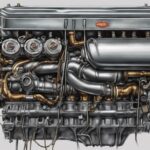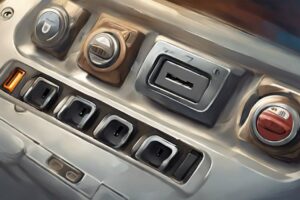A bad mass air flow (MAF) sensor is a very common problem that can cause a range of issues with a car’s performance. One of the most common symptoms of a bad MAF sensor is a check engine light on the dashboard. However, it is possible to have a bad MAF sensor without the check engine light illuminating.
This can make it difficult to diagnose the problem and can lead to further issues down the line. When a MAF sensor goes bad, it can cause a variety of problems that can include issues with acceleration, fuel economy, and engine power. In some cases, a bad MAF sensor can even prevent a vehicle from starting.
However, when there is no check engine light on the dashboard, it can be difficult to pinpoint the cause of these issues.
How can you tell if a mass airflow sensor is bad? (If There Is No Check Engine Light?)
A mass air flow (MAF) sensor is a crucial component of a vehicle’s electronic fuel injection system. It measures the amount of air entering the engine and calculates the total amount of fuel needed for proper combustion. The MAF sensor helps to ensure that the engine runs efficiently and smoothly, and it plays a key role in reducing emissions.
How a Mass Air Flow Sensor Works
A mass air flow sensor works by measuring the amount of air that enters the engine. The sensor is typically located in the air intake system, between the air filter and the throttle body. It consists of a hot wire or film, which is heated to a specific temperature. As air flows over the wire or film, it cools it down. The amount of cooling that occurs is directly proportional to the amount of air that is flowing over the wire or film.
In a lot of cases, a bad mass airflow sensor will not trigger the check engine light on the dashboard. However, the symptoms of a bad MAF, such as poor acceleration, rough idle, and stalling, will still be present.
If these symptoms are present, it is important to investigate the problem further and have the mass airflow sensor checked to prevent potential damage to the engine.
Here are a few of the symptoms of a bad MAF that may be happening even if there is no check engine light.
Symptom 1. Poor Acceleration
A bad MAF can cause poor acceleration. The MAF is responsible for measuring the amount of air entering the engine and adjusting the fuel supply accordingly.
If the MAF is faulty, it will not be able to accurately measure the air entering the engine, causing the engine to receive too little or too much fuel. This can result in a lean or rich fuel mixture, which can cause the engine to hesitate or stumble during acceleration.
In some cases, the engine may also experience a complete loss of power with little or no acceleration power resulting in hesitation, or jerking while driving.
Symptom 2. Rough Engine Idle
Another symptom of a bad MAF is a rough engine idle. The MAF helps regulate the air-fuel mixture in the engine, and if it is not functioning properly, the engine may run too lean, causing the engine to idle roughly. This can be felt as a shaking or vibrating sensation in the vehicle.
Symptom 3. Stalling Or Surging
A bad MAF can also cause the engine to stall or surge. When the MAF is not working correctly, the engine may receive too much or too little fuel, causing it to stall or surge during acceleration or deceleration.
Symptom 4. Bad Fuel Economy
A faulty MAF can also cause a decrease in fuel economy. If the MAF is not accurately measuring the air entering the engine, it can cause the engine to receive too much fuel, resulting in a rich fuel mixture and decreased fuel efficiency.
Symptom 5. Difficult Engine Starting
A bad mass airflow sensor (MAF) can cause difficult engine starting by restricting the fuel being pumped into the engine. If the MAF is not functioning properly, it will send the ECU inaccurate signals about the amount of air entering the engine, which can cause the ECU to deliver the wrong amount of fuel.
This can result in a lean or rich air-to-fuel ratio, which can cause the engine to have difficulty starting. The engine may also experience extended cranking or stalling after starting.
What Causes A Bad Mass Air Flow Sensor With No Check Engine Light
Mass airflow sensors can fail for many reasons and this can cause issues without triggering the check engine light.
Usually a MAF will fail because of old age and normal wear and tear or exposure to dirt, dust or high temperatures. This can occur for many reasons such as a dirt getting through the air filter and onto the sensor surface, vacuum leaks around the intake manifold, faulty wiring and problems with other engine sensors such as a failed oxygen sensor or manifold pressure sensor.
Here are a few of the most common reasons why a MAF will fail.
Cause 1. Dirty Air Filter
A dirty air filter can cause a bad mass air flow sensor with no check engine light. If the air filter is dirty or clogged, it can restrict the amount of air that flows into the engine, which can cause the MAF to give incorrect readings.
This will cause the ECU to deliver the wrong amount of fuel, and potentially cause the MAF to fail over time.To prevent this issue, it is recommended to replace the air filter every 12,000 to 15,000 miles or as recommended by the vehicle manufacturer.
Dirt or debris from a dirty air filter can also cause a mass airflow sensor to fail or become contaminated. If the air filter is not installed properly or is old and damaged, dirt particles from outside air can enter the MAF and cause damage to the sensor. This will cause the MAF to give incorrect readings, which can cause the engine to run poorly or even stall.
Cause 2. Intake Vacuum Leaks
Intake vacuum leaks can also cause a bad mass air flow sensor with no check engine light. A vacuum leak occurs when there is a crack or hole in the intake manifold or vacuum hoses, causing air to enter the engine without passing through the MAF sensor.
This can cause the MAF sensor to read less air than the engine is actually receiving, resulting in poor performance and fuel economy. To diagnose a vacuum leak, a mechanic can use a smoke machine to detect any leaks in the intake system.
Cause 3. Dirty Sensor Surface
A dirty sensor surface will also lead to a bad mass air flow sensor, sometimes with no check engine light. Over time, it’s normal for dirt and debris to accumulate on the sensor surface, leaving it less able to read air volume accurately.
This will inevitably lead to poor performance and a decrease in fuel economy. To prevent this issue, it is recommended to change the air filter regularly and to clean the sensor surface with a proper MAF cleaner around every 50,000 miles. Usually, cleaning the MAF is only a temporary fix and replacing the sensor is often necessary in the long run.
Effects of a Bad Mass Air Flow Sensor
When the mass air flow sensor (MAF) in a vehicle fails, it can cause a variety of issues, related to fuel efficiency, engine performance, and engine reliability.
While a check engine light is often an indicator of a faulty MAF, there are instances where the sensor can fail without triggering the light. In this section, we will explore the effects of a bad MAF sensor and how it can impact a vehicle’s performance.
1. Reduced Fuel Efficiency
One of the most common effects of a bad MAF sensor is reduced fuel efficiency. The sensor helps the ECU determine the correct amount of fuel to inject into the engine, based on the amount of air entering the engine. When the MAF sensor is not functioning properly, the ECU may compensate by injecting too much fuel, resulting in poor fuel economy. This can be especially noticeable during highway driving or when accelerating.
Other symptoms of that are related to low fuel efficiency may include a decrease in engine power, difficulty starting the engine, and a rough idle. If left unchecked, a bad MAF sensor can also cause damage to other components in the engine, leading to more expensive repairs down the line.
2. Engine Stalling
Another effect of a bad MAF sensor is engine stalling. The sensor helps regulate the composition of the fuel mixture, which is critical for proper combustion. When the MAF sensor is not working correctly, the engine may receive too much or too little fuel, causing it to stall or hesitate during acceleration. This can be especially dangerous in situations where the driver needs to accelerate quickly, such as merging onto a highway or passing another vehicle.
3. Damage to The catalytic converter and oxygen sensors
A bad mass airflow sensor can cause damage to the catalytic converter. If the MAF gives incorrect readings, it can cause the engine to run rich which can result in incomplete combustion and unburnt fuel in the exhaust fumes.
A rich fuel mixture can damage a catalytic converter by causing it to overheat and melt. The catalytic converter is designed to reduce harmful emissions from the exhaust system by converting them into less harmful substances through a chemical reaction. However, if there is too much fuel in the mixture, the excess fuel can enter the exhaust system and cause the catalytic converter to overheat.
This can cause the ceramic substrate inside the converter to melt and clog the exhaust system, which can result in reduced engine performance, increased fuel consumption, and potential engine damage.
What Next – Diagnosing a Bad Mass Air Flow Sensor
As outlined previously, a bad mass air flow sensor can cause a variety of issues, such as poor fuel economy, rough idle, and engine stalling. Therefore, it is important to diagnose and possibly replace the sensor as soon as possible to avoid further damage to the engine. Here are some signs that indicate a bad mass air flow sensor:
- The engine hesitates or stalls when accelerating.
- The engine runs rough or idles poorly.
- The engine consumes more fuel than usual.
- The engine emits black smoke from the exhaust pipe.
- The engine lacks power or acceleration.
If your car is experiencing a drop in engine performance but there are no engine codes or a check engine light, there are a few steps you can take to diagnose the issue.
1. Testing The MAF with a Multimeter
One way to test a MAF sensor is by using a multimeter. Start by locating the MAF sensor on your vehicle. It is typically located between the air filter and the throttle body. Once you have found the sensor, unplug it from the wiring harness.
Set your multimeter to measure voltage and connect the positive lead to the signal wire on the MAF sensor.
The signal wire is typically colored green or blue. Connect the negative lead to a good ground on the vehicle. Turn the ignition to the “On” position and observe the voltage reading on the multimeter.
The voltage should increase as you rev the engine. If the voltage does not increase or is outside of the manufacturer’s specifications, the MAF sensor may be faulty and should be replaced.
2. Using a Scan Tool To perform a diagnostic
Another way to diagnose a bad MAF sensor is by using a scan tool. A scan tool can read the data from the MAF sensor and compare it to other sensors on the vehicle. This can help to determine if the MAF sensor is reading correctly or if there is another issue causing the symptoms.
Connect the scan tool to the vehicle’s diagnostic port and follow the manufacturer’s instructions to read the data from the MAF sensor. Compare the readings to the manufacturer’s specifications. If the readings are outside of the specifications, the MAF sensor may be faulty and should be replaced.
Replacing a Bad Mass Air Flow Sensor
How to Replace a Mass Air Flow Sensor
Replacing a bad mass air flow sensor is a straightforward process, but it requires some mechanical knowledge and tools. Here are the steps to follow:
- Disconnect the negative battery terminal to avoid any electrical shock.
- Unplug the electrical connector on the mass air flow sensor.
- Use a flathead screwdriver to unfasten the air intake hose clamp at the throttle body.
- Remove the air intake hose from the throttle body and air filter housing.
- Unbolt the mass air flow sensor from its housing using a socket wrench or pliers.
- Install the new mass air flow sensor in the same position as the old one.
- Reattach the air intake hose, electrical connector, and battery terminal.
It is important to note that some vehicles may require additional steps or tools to replace the mass air flow sensor. Therefore, it is recommended to consult the vehicle’s owner manual or a professional mechanic before attempting to replace the sensor.











I’m experiencing bad fuel economy and rough idling but no engine light is coming on. Could these be symptoms of a bad MAF sensor, and how can I confirm it myself before going to a mechanic?
I’ve been having issues with poor acceleration and uneven idling in my car, but no check engine light has turned on. Could these issues still be related to a faulty mass air flow sensor, and how can I confirm it without professional diagnostic tools?